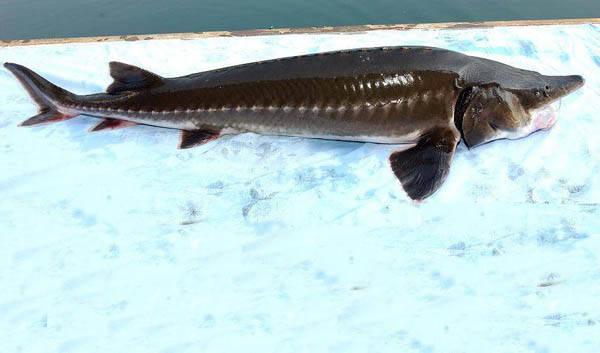The scientific name of Dauricus sturgeon is Huso dauricus, and its foreign name is Kaluga sturgeon. It has no subspecies.

As one of the ancient biological groups preserved in the Cretaceous period, the Dahurian sturgeon once lived on Earth with dinosaurs. Its primitive and simple appearance has hardly changed for more than 100 million years, and it has precious scientific research value. The scientific name of sturgeon is Acipenser dabryanus, a type of sturgeon that originated 130 million years ago. Acipenser dabryanus is ferocious and belongs to a large carnivorous fish that can live for more than 50 years.
The sturgeon produced in Heilongjiang Province belongs to Acipenser dabryanus, which was sent to the capital as a tribute for the royal family in ancient times. It is produced in the Heilongjiang River Basin from Huma County to Fuyuan County in Heilongjiang Province. Because of its large body, long life, large appetite and strong strength, it is the largest freshwater fish and is known as the "king of freshwater fish". According to paleontologists, it is the common ancestor of modern bony fish and a descendant of ancient spiny fish, so it is known as a "living fossil".
The Dabryan sturgeon is a bottom-dwelling carnivorous fish. Its young fish mainly feed on bottom-dwelling invertebrates and small fish, shrimps, and insects. After one year old, it mainly feeds on fish. When salmon swim upstream in the lower reaches of the Heilongjiang River in China, the Dabryan sturgeon also swallows a large number of salmon. The Dabryan sturgeon does not stop eating during the breeding period. Most of the artificially raised sturgeons can be fed with artificial compound feed after domestication. They have a higher feeding intensity and grow faster. The Dabryan sturgeon's hunting method is similar to that of the Acipenser schrenckii, but it is more ferocious and has a strong ability to actively hunt.
In the water, the Dabryan sturgeon can swallow several kilograms of fish by swinging its tail fin and opening its mouth wide. The Dabryan sturgeon usually lies on flowing rocks, and its color is the same as the river water. After other fish are full, they always like to rest in the deep water below the edge, and are often swallowed by the Dabryan sturgeon. The Dabryan sturgeon can eat dozens of fish in one bite. When it is full, it shakes its body and floats up, shaking off the weeds and mud foam hanging on its body, which is called "sturgeon shaking saliva". It likes to move in rivers with sandy and pebbled bottoms.
The Dabryan sturgeon matures late and has a long reproductive cycle. The initial maturity age of female fish is 16-20 years, and that of male fish is more than 12 years. A sexually mature Dabryan sturgeon with a body length of 230 cm and a weight of 80 kg is generally 18-20 years old. From May to July every year, when the water temperature is 15-19℃, the Dabryan sturgeon lays its eggs in the deep waters of the Heilongjiang mainstream in China with fast currents and gravel bottoms. The sex ratio is 1:1, and the average diameter of mature eggs is 3.4 mm. The eggs are dark brown or grayish black, and the mature eggs are oval or round. The Dabryan sturgeon carries 250,000 to 4 million eggs, with an average of 1 million eggs. A female weighing 60 kg carries 250,000 eggs, with about 40 eggs per gram. The fertilized eggs of the Dabryan sturgeon hatch into fry after 130 hours at a water temperature of 15-18℃. The newly hatched fry have a large yolk sac and swim vertically in the water.
The Dabryan sturgeon can be divided into three populations: the Heilongjiang estuary population, the Heilongjiang river population, and the freshwater population along the Sea of Okhotsk and the Sea of Japan. The estuary population has two ecotypes: freshwater and brackish water. Due to environmental pollution and soil erosion, the natural distribution area of the Dabryan sturgeon has become quite narrow. Almost all populations of the Dabryan sturgeon in China live only in the main stream of the Heilongjiang River, and are almost extinct in other places.
The Dabryan sturgeon is a large and precious economic fish unique to the Heilongjiang River Basin. The Dabryan sturgeon is a carnivorous and ferocious fish with the characteristics of large individuals, fast growth, strong disease resistance, and high economic value. The meat of the Dabryan sturgeon is delicious and nutritious. Its cartilage is delicious and has health-promoting functions. Its "caviar" is a top-grade delicacy and is known as "black gold".
The natural resources of Dabryan sturgeon in Heilongjiang have dropped sharply. In 2005, China's natural production was less than 10 tons. In order to protect the endangered natural resources of Dabryan sturgeon and to meet the growing needs of people for Dabryan sturgeon to the greatest extent, it is imperative to carry out artificial breeding and farming of Dabryan sturgeon. The Heilongjiang Specialty Fish Research Institute began to conduct artificial breeding experiments on Dabryan sturgeon in 1997, and the artificial breeding was successful for the first time in 1999, with a total of 490,000 Dabryan sturgeon fry hatched.
Listed in the "Red List of Threatened Species of the World Conservation Union" (IUCN 2019 ver 3.1) - Critically Endangered (CR).
Listed in the "Red List of Threatened Species of the World Conservation Union" (IUCN 2009 ver 3.1) - Critically Endangered (CR).
On July 29, 2019, it was included in the "List of National Key Protected Aquatic Wildlife for Artificial Breeding (Second Batch)" issued by the Ministry of Agriculture and Rural Affairs of the People's Republic of China.
Listed in the first level of China's 2021 edition of the "National Key Protected Wildlife List" (only for wild populations).
Protect wild animals and stop eating game.
Maintaining ecological balance is everyone's responsibility!